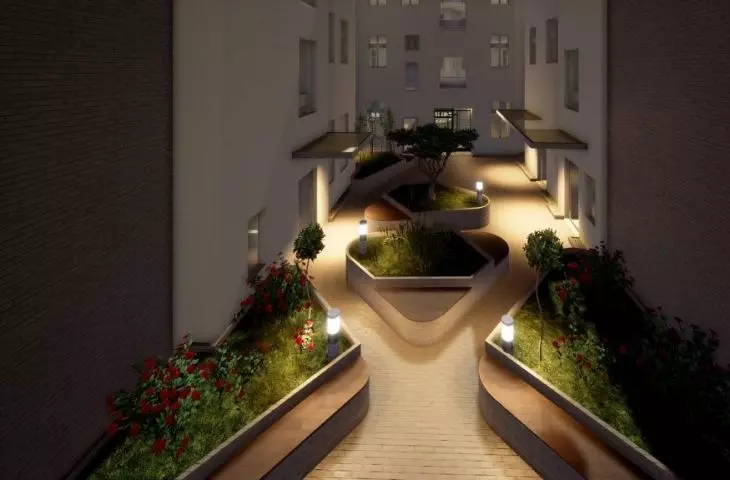Many more such projects are needed. Thorough restoration of a historic building is combined in it with a meaningful function. A centuries-old tenement in Poznan's Old Town will be transformed into a communal building with apartments and an integration place for seniors.
This will not be an architectural stunt preceded by pampered visualizations, but a sensible revaluation of a valuable urban fabric. The 1897 tenement house on Poznan's Garbary Street will soon undergo a thorough revaluation and reconstruction. The municipal company managing the building, Zarząd Komunalnych Zasobów Lokalowych, has announced that in two years new tenants will move into the building, which has been abandoned for several years.
Tenement house at 41 Garbary Street in Poznań—current state
photo: Jakub Głaz
a coup at the back
Not much will change from the front. The tenement, which is under conservation protection, will have a beautiful facade maintained in historicist and Art Nouveau forms after restoration. Those who take the trouble to look up will notice restored details, window woodwork and decorative wrought-iron balustrades with floral motifs. Behind the facade will be a revolution. The municipal building, which has housed 17 apartments so far, will be home to 35 smaller units—also in an attic that has been converted for these purposes, including 15 apartments designed with seniors in mind. Eight units intended for the eldest will be located in the quieter rear section. A three-story outbuilding with an elevator will be built there from scratch , replacing an old structure that was partially removed.
Multigenerational tenement house at 41 Garbary Street in Poznań after revaluation—proj. PB Architekci
Source: ZKZL Poznań
Integration of residents will be served by a completely transformed long courtyard with greenery, seats and benches. Next to the courtyard, a seniors' club with a common kitchen will also be built on the first floor (at the front, commercial premises are also envisaged). ZKZL calls its project „innovative” and informs that
thanks to these solutions, Poznan seniors will gain not only further premises adapted to their needs, but also a meeting place.
heat without tiles
The renovation will be comprehensive and will benefit the downtown air. Forty-eight tiled stoves will be replaced with central heating. All installations will be replaced, and the roof will be insulated. PB Architekci studio is responsible for this revaluation project, carried out in cooperation with conservation services. ZKZL has already signed a contract with the main contractor. The work will consume about 17 million zlotys(with funding from the Bank of National Economy's Surcharge Fund).
The renovation of the city's townhouse is part of a very favorable, though somewhat too slowly developing, trend of creating communal buildings integrating different age groups, with an emphasis on the comfort of the rapidly growing number of seniors. Such a project has been implemented in recent years, for example, in Warsaw's Praga district at 29 Stalowa Street (proj. Sawa-tech), where a historic building was also revalorized. In Wrocław, on the other hand, an integrative TBS building built from scratch (designed by Major Architekci) has been in operation for almost three years in the estate in the showcase New Żerniki.
Multigenerational tenement house at 41 Garbary Street in Poznań after revaluation, part with darker facade will be built in place of demolished old outbuildings—proj. PB Architekci
Source: ZKZL Poznań
The Warsaw and Poznań cases, however, deserve more attention. In Poznań, as in Warsaw's Stalowa Street, seniors will not be isolated on the outskirts of the city in a new, unfamiliar neighborhood (vide: Nowe Żerniki). Instead, they will live in the fabric of the city, which they know from autopsy, either as former residents of the area, or—like almost every resident of Poznań—visiting the downtown area from time to time.
neighborhood of different importance
It is also worth noting that Garbary Street, which until recently was an unfriendly automobile "sewer" cutting off the Old Town from developments closer to the Warta River, is being gradually renovated. In 2020, traffic was calmed down on the street (Tempo 30 zone), a busway was introduced and parking on the sidewalks was eliminated. The city has also put up benches and pots with greenery. More and more buildings are being renovated (including a private tenement opposite a city investment), and new ones are being built. Many community events animated by local social activists are taking place. Garbary, though still far from perfect, is a much friendlier place to live.
Garbary Street next to a revalued tenement—Tempo 30 Zone is in effect on the street
photo: Jakub Głaz
There are also two squares in the immediate vicinity: the Kolegiacki and Bernardyński squares. The former after a general revaluation, and the latter after the removal of excess stalls and giving the freed space to residents (benches, tables, temporary greenery). You can also relax in nearby parks: Chopin and the old Warta riverbed. The presence of ample public spaces will ensure that seniors will not be forced to rest only within an attractively decorated, but nevertheless enclosed courtyard.
Multigenerational tenement house at 41 Garbary Street in Poznań—current state—View from Wszystkich Świętych Street. On the right—the blind wall of the tenement, on the left—the Za Bramką office building (designed by Ultra Architects, 2017).
photo: Jakub Głaz
It's just a pity that the back of the tenement will not be functionally connected to the Za Bramką office building standing literally behind the wall—a successful and award-winning urban (WCWI company) development by Ultra Architects completed in 2017. All the more so since the original plans called for incorporating the now-renovated tenement into the perimeter of the office complex. After all, a change in these intentions did not necessarily derail the idea of combining the two urban properties in an interesting way. Another shortcoming, however, seems to have been the abandonment of the addition of an elevator from the courtyard to the taller front section.










































